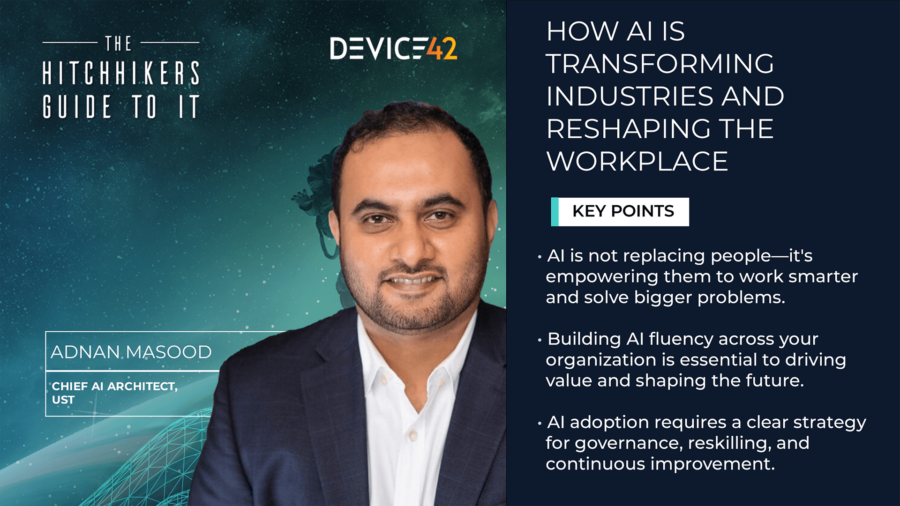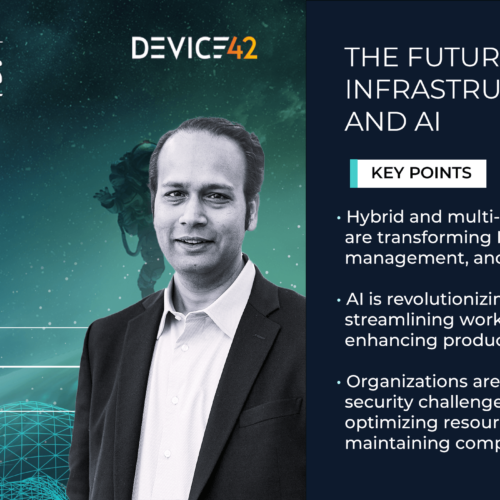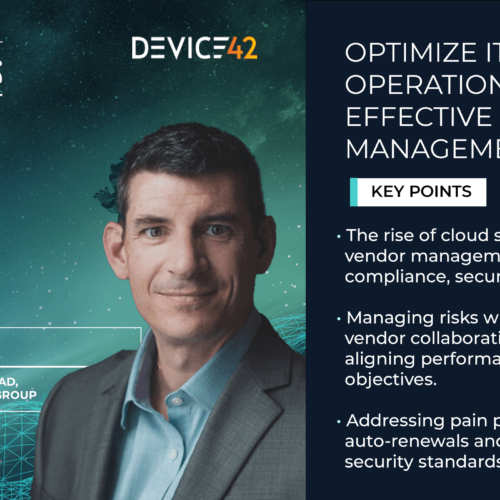Artificial intelligence (AI) is rapidly transforming industries, business models, and products and services. CXOs are using advanced technology to empower workers with role-specific copilots, enable cross-functional collaboration and decision-making, and redesign workflows with agentic AI. They see AI as a tool to increase innovation and operational efficiency while creating a competitive edge. Nearly all CXOs (91%) believe they can use AI to outpace rivals.
Against that market backdrop, host Michelle Dawn Mooney welcomed Adnan Masood, PhD., to “The Hitchhiker’s Guide to IT, Device42’s podcast, to discuss “How AI Is Transforming Industries and Reshaping the Workplace.” The podcast can be viewed here.
| The Purpose of This Blog This blog provides IT operations professionals with insights into how enterprises are deploying AI solutions and strategies to scale AI adoption. |
Masood is the Chief Architect for AI and Machine Learning at UST, a digital technology and transformation consulting firm. He is also a Microsoft Regional Director and a visiting scholar at Stanford University, where he worked under Christopher Manning, one of the world’s leading natural language processing researchers.
Masood said his job operates at the intersection of academia and industry. He leverages cutting-edge research from Manning’s Stanford Artificial Intelligence Laboratory (SAIL) and the MIT Computer Science & Artificial Intelligence Laboratory (CSAIL), as well as hyperscale solutions from Microsoft, AWS, and Google Cloud Platform to bring best-in-class algorithms, techniques, and tools to UST’s customers. He collaborates closely with Fortune 100 corporation board members, CXOs, and teams of developers, engineers, and data scientists to develop scalable AI solutions that can be deployed safely, securely, ethically, and responsibly.
How AI Trends Are Impacting Workplace Dynamics
Host Mooney asked Masood how AI trends are impacting the workplace, including roles, responsibilities, and workflows.
Masood said that leading enterprises have deployed AI copilots, such as UST’s Chord Crafter, that use automation and augmented intelligence to transform core processes such as HR and marketing workflows. AI has already automated low-impact work, such as filling in timesheets, completing HR forms, or writing text, enhancing employee productivity. However, companies are increasingly building cognitive ecosystems with AI solutions to drive decision-making, increasing operational transparency and agility. In 2025 and beyond, companies will be focused on developing agentic AI systems that can understand context, automate processes, learn from feedback, and adapt their approach. As a result of these fast-paced changes, enterprises need to hire and develop more AI governance experts to manage the pivot from humans guiding all decision-making to AI driving most decisions under human oversight.
How Cutting-Edge AI Research Influences Real-World Business Strategies
UST’s clients are seeking to push the boundaries of what AI can achieve to develop intellectual property and competitive advantage in the market.
Masood leverages his SAIL relationship to gain thought leadership and R&D for new solutions, with UST implementing them. “So, whether it’s in natural language processing or reinforcement learning, we’re seeking to apply models to specific business areas, such as claims processing in healthcare or fraud detection in financial services,” said Masood. “Our relationship with SAIL enables us to be at the forefront of AI research.”
SAIL provides a framework for conducting a holistic evaluation of large language models, with benchmarks and quantitative data to assess performance and detect bias. These tools help UST develop and deploy advanced technology solutions aligned with the latest AI ethical standards, adhering to its core principles for AI while providing companies with new business value. “So, there’s institutional legitimacy to our work,” said Masood.
Industries Where AI Is Driving the Greatest Transformation
UST works with leading healthcare, finance, retail, and manufacturing companies to deploy AI solutions. AI-driven forecasting and AI copilots that streamline role-based workflows are also “killer use cases.” Many people use copilots as an augmentation tool, such as writing emails. However, when it comes to AI-driven insights, you need custom applications based on your domains and your data,” Masood said.
Masood cited examples of how AI is transforming healthcare, such as enabling clinicians to create personalized plans for patients and empowering customer service agents at insurers to provide relevant information to members, such as plan coverage and copays. Instead of digging through databases and documents, agents get personalized answers at their fingertips to provide relevant service that delights customers.
UST also works with financial services organizations to implement fraud detection algorithms that streamline end-to-end processes from loan processing to credit risk assessments. A major area of focus is ensuring that model processes and decisions are explainable. Masood says that his company leverages open-source algorithms and builds their own intellectual property on top of it, using techniques such as Shapley values and counterfactuals to analyze algorithms and explain their reasoning.
In retail, UST is helping clients personalize customer experiences to “create a competitive moat around using their data,” stated Masood. “Retail is a tight-margin industry where you have to have superior data-driven insights.”
Balancing AI Innovation with Ethical Considerations
Enterprises are grappling with AI ethical considerations, such as data privacy and workforce impacts. New regulations are coming to the fore, such as the European Union’s AI Act, which requires that organizations categorize AI applications by risk level: high, medium, and low, as well as systems that pose unacceptable risks. The regulation takes effect February 2, 2025, with a ban on systems creating unacceptable risks and enforces a code of practice nine months later. Leaders must also understand how systems that comply with the General Data Protection Regulation (GDPR) can maintain these protections when used with AI.
“Whenever I talk to CXOs and board members, I discuss balancing innovation with purpose-driven strategy. What is the mission and purpose of your organization? AI solutions must be developed and deployed with transparency, accountability, and privacy in mind,” said Masood.
This process starts at the outset of every AI initiative. UST uses a framework called Responsible Rails, which provides checklists to help users establish ethical governance and mitigate bias. “So, we have to ensure that the businesses can innovate responsibly without compromising user trust or data security because that is a fiduciary responsibility and a brand issue,” said Masood.
Addressing Common Misconceptions About Using AI in the Workplace
The AI industry is growing so fast that hype is outpacing reality. Masood said one of the top misconceptions about AI is that its adoption will lead to widespread adoption job losses. However, the truth is more complicated. While AI will displace some workers, it will create a demand for new skills, leading to 7% employment growth between 2025 and 2030, or 78 million new jobs.
“AI creates opportunities for strategic reskilling. It augments AI capabilities and enables humans to work at a higher cognitive level,” said Masood. “As a result, employees can focus on creative problem-solving and high-level decision-making.”
To prepare its workforce for AI, UST is training 25,000 staff on AI topics and skills and helping them adopt a spirit of continuous learning. The company is also upskilling its customers on AI tools like GitHub CoPilot and AWS solutions.
A second misconception about AI is that it can be deployed as an off-the-shelf solution. “Successful AI deployments require agile governance, continuous learning, and a deep understanding of the domain,” said Masood. Companies should search for partners who have a contextual understanding of their data and business processes so that they can build solutions that automate the right processes and deliver relevant insights.
“This process requires time, investment, and a culture of cognitive diversity. People need to be able to learn from AI in an environment of psychological safety,” said Masood.
While AI systems are getting better at making decisions, they still need humans in the loop for high-risk applications, such as making loan approvals or automating workflows for employee hiring. Masood said that mistakes, such as demonstrating bias with credit limits, can expose firms to legal action and brand harm.
Strategies to Facilitate a Successful, Sustainable AI Integration Process
As Masood speaks with CXOs and board members, he offers the following strategies on how companies can get started with AI. They include:
- Understanding the business’s core competencies: Successful companies should not change their businesses with AI but identify ways to accelerate their core competencies and capabilities with this advanced technology.
- Adopting an ethical AI strategy: Leaders should ensure that models follow responsible AI principles. They should be transparent, explainable, fair, safe, and auditable.
- Implementing a data governance framework: Companies must create a data culture and set up processes to create a source of good, clean data for AI innovation that stakeholders will trust.
- Enabling use cases that deliver real ROI: Masood works with companies to identify high-value use cases with a real need, the urgency to act, and demonstrable ROI. For example, use cases that foster cross-functional collaboration can enable greater experimentation, create synergy, and build an AI-driven culture.
- Cultivating a spirit of continuous learning and innovation: Employees should be encouraged to use new tools and processes and take risks, such as building solutions they can use in their workflows. “Build a culture of experimentation where people are allowed to fail fast, refine ideas, and build on top of them,” said Masood. Citing The Digital Mindset’s 30% rule, Masood says that employees should work to develop a 30% vocabulary level with AI: understanding basic algorithms and how unsupervised, supervised, and deep learning work. With that level of AI literacy, employees can contribute to guiding their organizations through transformational change.
AI Resources to Explore
Host Mooney asked Masood for recommendations that podcast listeners could explore. Masood recommended:
- The Digital Mindset: What It Really Takes to Thrive in the Age of Data, Algorithms, and AI, by Paul Leonardi and Tsedal Neeley
- Responsible AI in the Enterprise, Masood’s book co-authored with Heather Dawe, Chief Data Scientist of UST
- The University of Southern California’s generative AI webpage
- How application modernization future-proofs organizations, a UST white paper
- Responsible AI: Forging the path to reliable and ethical AI implementations, a UST insights paper
Lead – Don’t Lag – with AI Innovation and Adoption
Masood exhorted listeners to act now to become AI leaders and increase their companies’ intellectual property and presence in the industry. “The future belongs to the enterprises that integrate AI responsibility responsibly and balance innovation with ethics, privacy, and workforce. Businesses must act now to build AI fluency and prioritize AI-driven value creation to create dominance. In the process, you will redefine markets, unlock new business models, and build operational excellence, which is essential to your enterprise,” he concluded.
Want to learn more?




